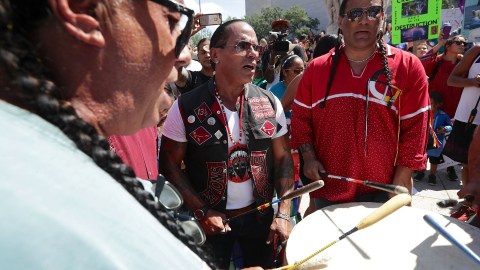Native Americans Passionately Protest New Dakota Pipeline

Since April, hundreds of representatives from numerous tribes across the United States have been gathering in North Dakota to stage a passionate protest. What they are protesting is the $3.7 billion Dakota Access Pipeline (DAPL). The 1,170-mile project starts in western North Dakota and goes all the way to Illinois.
Standing Rock Sioux tribe’s land lies just next to the planned path of the oil pipeline. The 8,000-member tribe is vehemently opposed to the project’s environmental and cultural impact. The tribe sees a strong potential that the pipeline would cause a catastrophe if it leaks or breaks, ruining their water supply and sacred sites.
One particular issue is the involvement of Enbridge Inc., a stakeholder in the pipeline. Enbridge has a mixed record on oil spills. In 2010, one of its pipelines had one of the worst inland spills in American history, spilling 1.2 million gallons of oil into the Kalamazoo River.
They Sioux tribe blames the US Army Corps of Engineers for failing to properly review cultural and historical factors before granting the pipeline federal approval. For their part, the Corps says it did consult the tribes and no one described specific cultural sites that the pipe would damage.
The tribe filed a lawsuit agains the Corps of Engineers for violating the National Historical Preservation Act, among other laws, and asked a federal judge to halt the construction.
The Texas-based Energy Transfer Partners did briefly halt construction while waiting fora judge to decide whether to allow the pipeline construction to proceed or to grant an injunction to stop it. It has resumed.
The protests continue. As North Dakota’s governor declared a state of emergency there, the protesters built a teepee camp and have been wearing traditional regalia and paint on their marches. It’s common to see drum circles and horse riders. Every day, the protesters march a mile up a highway to the construction site.
Here’s what the atmosphere is like at the protests:
The Sioux protesters have been joined by the Lakota, Apache, Navajo, Cheyenne as well as members of other tribes and environmental activists from across the nation. Also lending their voices of support have been celebrities like Leonardo DiCaprio, Susan Sarandon, and Shailene Woodley.
While the protests have been peaceful, about 30 people have been arrested so far.
Many of the protesters see the issue as a continuation of the centuries-old government’s policy of breaking treaties and depriving Native Americans of their land and rights.
Talking to the New York Times, Dave Archambault II, the tribal chairman of the Standing Rock Sioux,
“Lands were constantly getting reduced, shaken up. I could give you a list of every wrongdoing this government did to our people. All of that is frustration pent up, and it’s being recognized. It’s a tipping point for our nations.”
The irony of having to fight against further intrusion on land that used to belong to them is also not lost on Phyllis Youngof the Standing Rock Sioux, who told to New York Times:
“This is our homeland. We are Dakota. Dakota means friend or ally. Dakota Access has taken our name.”
The fight over the pipeline has caused thousands of people to lend their support to the Native Americans online. You can add your voice here:
CHANGE.ORG’s “Stop the Dakota Access Pipeline” petition
cover photo: Members of a drum group sing during a rally on Dakota Access Pipeline August 24, 2016 outside U.S. District Court in Washington, DC. Activists held a rally in support of a lawsuit against the Army Corps of Engineers ‘to protect water and land from the Dakota Access Pipeline,’ and to call for ‘a full halt to all construction activities and repeal of all pipeline permits until formal tribal consultation and environmental review are conducted.’ (Photo by Alex Wong/Getty Images)





